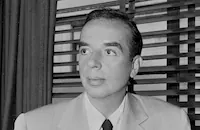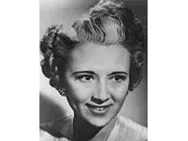Undercurrent

Brief Synopsis
Cast & Crew
Vincente Minnelli
Katharine Hepburn
Robert Taylor
Robert Mitchum
Edmund Gwenn
Marjorie Main
Film Details
Technical Specs

Synopsis
When industrialist Alan Garroway is introduced to Ann Hamilton, the unsophisticated daughter of chemistry professor "Dink" Hamilton, he falls instantly in love with her and proposes marriage. A short time after their wedding, Ann accompanies Alan on a trip to Washington, D.C., where she is introduced to Mr. Warmsley, Alan's manager, and many of Alan's socialite friends. Her plain clothes and lack of style embarrass Ann, who then tearfully asks Alan to show her how to dress and behave. One day, Alan tells Ann that after his father died he and his brother Michael took over their father's mechanical gadget business, and that he has not seen or heard from Michael since Michael was caught stealing from him. While visiting Alan's family home in Middleburg, Virginia, Ann is startled when a horse suddenly becomes wild in the stable, and later learns from the stablehand that Alan once beat the horse severely. Later, when Alan angrily orders Ann to cease playing a familiar tune on the piano, she begins to suspect that his odd behavior is symptomatic of some deep psychological wound. Her suspicions are confirmed when George, the estate caretaker, tells Ann that the song she was playing was one that Michael used to play. Believing that Alan has been deeply hurt by his brother's betrayal, Ann decides to help her husband overcome his problems. After Alan leaves for Seattle on a business trip, Ann visits his office and asks Warmsley to give her directions to Michael's ranch house near the ocean. At the house, Ann meets Michael, but she is not aware of who he is because he introduces himself to her as the caretaker. Later that night, Alan comes back to Seattle and surprises Ann at the house. He angrily demands to know why Ann is there, and Ann tells him that her only interest is to save their marriage and to help him by finding out more about his past. Alan returns to Seattle to resume his business while Ann returns to Middleburg. When Alan returns to Middleburg, Michael accuses him of having killed an engineer at their plant in order to steal his plans for a remote control explosive device. Michael tells Alan that he has decided to expose his crime now because he met Ann and believes that she is too fine a person to be involved with a murderer. When Alan informs Michael that he has reformed and that he plans to tell Ann the truth about his past, however, Michael decides to remain silent about the murder. Fearing that Ann will leave him if he confesses the truth, Alan keeps his past a secret and vows to let nothing and no person come between them. Ann later confesses that she is obsessed with thoughts of Michael and that she wants to meet him so that she can forget him. As Alan grows insanely jealous of Ann's obsession with his brother, she becomes fearful of him and tries to escape from the house. Alan prevents Ann from leaving, and realizes that he must kill her to prevent her from leaving him again. While Alan and Ann ride on horseback to visit a friend, he makes a failed attempt to push her off a steep ledge. Ann races ahead for help but falls off her horse when she hits a branch. Alan catches up with Ann, but when he raises his arms to knock her on the head with a rock, his horse pounces on him with its hooves and kills him. Ann recovers at her father's home, where, one day, she is visited by Michael. Ann tells Michael that she knew who he was a short time after they met, and that she wanted to see him again. After Michael tells Ann that he has special feelings for her, the two play a duet on the piano.

Director

Vincente Minnelli
Cast

Katharine Hepburn

Robert Taylor

Robert Mitchum

Edmund Gwenn

Marjorie Main
Jayne Meadows

Clinton Sundberg
Dan Tobin
Kathryn Card
Leigh Whipper
Charles Trowbridge

James Westerfield
Billy Mcclain
Milton Kibbee
Jean Andren
Forbes Murray
David Cavendish
Ernest Hilliard
Clive Morgan
Reginald Simpson
Oliver Cross
Harold Miller
Frank Leigh
Dick Earle
James Carlisle
Ann Lawrence
Florence Fair
Laura Treadwell
Ella Ethridge
Hazel Keener
Maxine Hudson

Bess Flowers
Hilda Rhoades
Joan Thorsen
Barbara Billingsley
Sarah Edwards
Ellen Ross
Betty Blythe
Monya Andre
Helyn Eby-rock

Sylvia Andrew
Eula Guy
Wheaton Chambers
Gordon Richards
Rudy Rama
Dan Kerry
Phil Dunham
Sydney Logan
Hank Worden
Robert E. O'connor
William Eddritt
Jack Murphy
William J. Cartledge
Bert Moorehouse
Frank Dae
Nina Ross
Dorothy Christy
Jane Green
Rommy, The Dog
Crew
Pandro S. Berman
Johannes Brahms
Edward Chodorov
Jack Dawn
Katherine Doyle
Randall Duell
Norman Elzer
Karl Freund
Jack Gertsman
Cedric Gibbons
Sydney Guilaroff
Irene
Sol Martino
Jack D. Moore
Marguerite Roberts
Douglas Shearer
Herbert Stothart
Thelma Strabel
Ferris Webster
Edwin B. Willis

Photo Collections
Videos
Movie Clip



Film Details
Technical Specs

Articles
Undercurrent
The three lead actors, Hepburn, Robert Taylor, and Robert Mitchum, were all cast against type in Undercurrent. Hepburn normally played strong women characters. However, the role of Ann called for her to be timid and fearful much of the time. Robert Taylor, who was returning to the screen for the first time after serving in World War II, portrayed Hepburn's sinister husband Alan. He was a leading man used to being the hero of a picture, but in Undercurrent, audiences got a chance to see him in a darker and more complex role than he ever played before.
Robert Mitchum, in a rare sensitive "nice guy" role, was loaned out to MGM by RKO to make Undercurrent. He was a hot property at the time coming off the success of The Story of G.I. Joe (1945) for which he was nominated for a Best Supporting Actor Academy Award. Even so, Mitchum failed to impress Katharine Hepburn, who made her disdain for him known. Mitchum was also spreading himself a bit thin during the filming by working on two other movies - Desire Me (1947) and The Locket (1946) - at the same time. This grueling schedule prompted Vincente Minnelli to comment, "No wonder he became famous for his sleepy eyes."
At first Katharine Hepburn was also not thrilled to have Vincente Minnelli as her director. Though they had met several times before, Minnelli was still intimidated by Hepburn. "I'm sure we'll get along," Hepburn told Minnelli at the beginning of the picture. To him it sounded like "both an order and a threat," he recalled in his 1974 autobiography I Remember it Well. "Never had I met anyone with such self-assurance. She made me nervous." The two eventually did grow to be good friends once Minnelli learned how to handle the actress. Hepburn also took a welcome interest in Minnelli's newborn daughter, Liza, which pleased the proud first-time father. Initially, Robert Taylor was irritated at the developing friendship between his leading lady and the director and felt that Undercurrent was becoming a showcase for Hepburn. However, he soon relaxed once he realized Minnelli's directorial skills were actually improving his own performance.
Undercurrent is also highlighted by the gorgeous black and white cinematography of Karl Freund that conjures up a menacing atmosphere for the noir-like suspense thriller. Veteran character actors Edmund Gwenn and Marjorie Main play supporting roles, as does Rommy the dog, who was taught by the Rudd Weatherwax family, Hollywood's most prestigious dog trainers. Undercurrent was the first collaboration between Minnelli and Pandro Berman, and they would go on to make several other successful pictures together including Madame Bovary (1949) and Father of the Bride (1950).
Producer: Pandro S. Berman
Director: Vincente Minnelli
Screenplay: Edward Chodorov, George Oppenheimer, Marguerite Roberts
Art Direction: Cedric Gibbons
Cinematography: Karl W. Freund
Costume Design: Irene
Film Editing: Ferris Webster
Original Music: Herbert Stothart
Principal Cast: Katharine Hepburn (Ann Hamilton), Robert Taylor (Alan Garroway), Robert Mitchum (Michael Garroway), Edmund Gwenn (Prof. Dink Hamilton), Marjorie Main (Lucy), Jayne Meadows (Sylvia Burton), Clinton Sundberg (Mr. Warmsley).
BW-117m. Closed captioning.
by Andrea Passafiume

Undercurrent
Quotes
Trivia
Notes
The working title for this film was You Were There. Although the SAB lists writer Thelma Strabel's work, also titled You Were There, as a novel, the onscreen credits list it as a story and no evidence of its publication as a novel has been located. Actor Billy McClain's name was misspelled in the end credits as "McLain." This picture marked Jayne Meadows' motion picture debut and Robert Taylor's return to the screen following three years of service in the Navy. Meadows is listed under the name Jayne Colter in the CBCS. Modern sources note that M-G-M paid $25,000 to David O. Selznick for the loan-out of actor Robert Mitchum. Katharine Hepburn and Taylor recreated their roles for the Lux Radio Theatre version of the story, which aired on October 6, 1947. In February 1947, according to a Hollywood Reporter news item, a $250,000 damages suit was brought against M-G-M by Fay Ehlert, a playwright who charged the studio with misappropriating the film's title from a one-act play she had submitted to the studio. The outcome of the suit is not known.

Miscellaneous Notes
Released in United States Fall November 1946
Released in United States Fall November 1946













